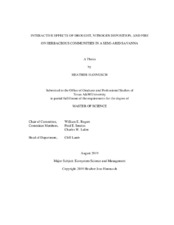| dc.description.abstract | Understanding the responses of savanna communities to disturbance and altered resource conditions will gain importance under climate-change induced modifications to precipitation patterns and nutrient cycling. This study investigates 1) how an herbaceous community within a semi-arid savanna will respond to drought, nitrogen deposition, and prescribed fire and 2) how these factors will interact to alter those responses. Sixty-four 5 x 5 m, herbaceous-dominated plots were established at the Texas A&M AgriLife Research Station on the Edwards Plateau, a generally rocky, shallow-soil savanna ecoregion (latitude 31°N, longitude 100° W). A prescribed drought treatment (rainout shelter or ambient), nutrient treatment (nitrogen addition or control), and fire treatment (burned or control) was assigned to each plot in a full factorial, completely randomized experimental design. Vegetation and topsoil data were collected to evaluate the treatment effects on both the vegetative community and also on the soil and vegetation chemistry.
The vegetative community responded rapidly to the treatments especially in terms of drought-reduced ANPP (ANOVA p<0.05) and a shift in community composition from the full combination of treatments (PERMANOVA p<0.05) after 8 months of treatments. After 12 months of treatments, forb ANPP was reduced by fires (ANOVA p<0.01) but increased by drought (ANOVA<0.05) When dominated by annual plants in the early spring (12 months after treatment), the community failed to exhibit a statistically significant shift in community composition. The soil chemistry was more recalcitrant to change and did not demonstrate treatment effects during the study period. Vegetation N, on the other hand, exhibited increases only when it had previously been burned. Under future environmental conditions, the herbaceous communities may be expected to experience alterations in a short time-frame while soil chemistry remains unchanged in the short-term. These results will provide insights into how managers and ecologists can use the feedbacks between prescribed fire, drought, and soil fertility to maintain biodiversity, desirable cover ratios, biomass production, and protect semi-arid savanna systems from degradation. | en |


